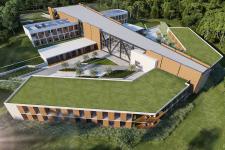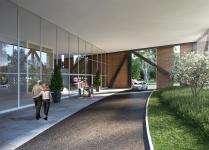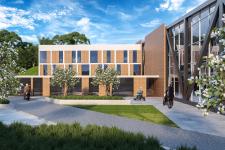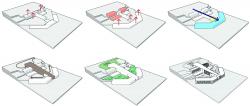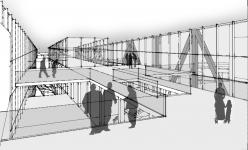The elderly represent an increasingly significant portion of the population in Brazil. A good part of the elderly population is healthy or has some slight physical disability that causes them to need assistance. The lack or low quantity and quality of stimuli and autonomy, along with the sedentarism, contribute to accelerate the process of old age. The purpose of this architectural project of the Residential of the 3rd age is to "Retrofit" a construction of an abandoned hospital with 70% of the concrete structure executed. The new building aims to: prevent and promote physical and mental health; preserve and stimulate remaining physical and psychological capabilities; especially the socialization of the elderly. These demands will be met considering their physical and psychological characteristics, through the appropriation of spaces gearedtowards leisure, recreation, social interaction, culture, special services (such as the medical-ambulatory sector). The target population of the proposal consists primarily of elderly people, over 60, independent or semi-dependent, lucid or not, who can enjoy the type of service provided by the institution. The project located in the city of Caxias do Sul, in the extreme south of Brazil, in order to provide a welcoming environment for both patients and health professionals, we introduce a concept that is attractive, accessible and supportive, creating a positive space capable of acting as a center of social activity, not only a place of housing for the elderly, meeting the users' needs, besides the formal, functional, technical and compositional aspects of the architecture, it was also a challenge to harmoniously insert the architectural project in the pre-existing concrete structure of the Hospital dated 1994. The project aims to be an open space for the community, where the first element to consider was the exterior of the building and its materiality, such as the foundation and the existing "cast in place" concrete structure, first point of connection between the user and the environment. Instead of treating only a general volume of functions as in the "old" project, a volumetric proposal was developed, taking advantage of the existing circulation axis, which defines two squares with different uses, and thus develop two wings that house the volumes that contains dorms, activities and services. The main access takes place through a large square at the top level of the terrain, whose difference is 12.00m, with a strong marking of access on the central axis that shelters the arrival of users and visitors. The whole complex is organized through the central axis that accommodates the unevenness of the terrain. This axis, in addition to organizing the spaces, also directs and directs people to the interior of the building through its empty spaces with shops, cafes, clinics, exhibitions that integrate the ample space bathed by natural light. Such a pleasant space turns out to "oxygenate" the user experience. The volumetry of the central axis is configured by a metallic structure, "shell" independent of the old concrete structure, and the inclined thermal insulation cover this volume is adapted in the topography, with interaction between the internal and external environment due to its glass closure. The project was divided into two wings of care: the upper wing at the highest part of the land accommodates the elderly who need more assistance and outpatient care. Already in the wing located in the inferior levels of the ground we have the apartments and suites for the elderly more independent, and in the intermediate level we find the convivial areas, restaurant, rooms multiples uses and green squares. The materials chosen were wood and brick, where these materials seek to bring users closer to their origins and residential memory through their color and texture, while steel and glass allow lightness with the integration of external nature, as well as a notion of appropriate modernity for health buildings. Several sustainable systems such as solar panels, thermal panels, green roofs, reuse of rainwater stored in the inclined roofing volume, and the use of 100% of the abandoned concrete structure since 1994 will be implemented. The values that prevail in the project are clearly expressed in their volumetry, as the upper volume of the building emerges from the earth, wanting to be the business card for the users.
2018
0000
Client: Randon
Gross Floor: Area 9.400,00 m²
Design teamAlberto Torres and Audrey Bello Ramos
Main ContractorExacta Engenharia
Photo Credits3D imagem
Torres & Bello Architects + Exacta Engenharia
Design team:
Alberto Torres
Audrey Bello Ramos
Ayrton Uchoa

